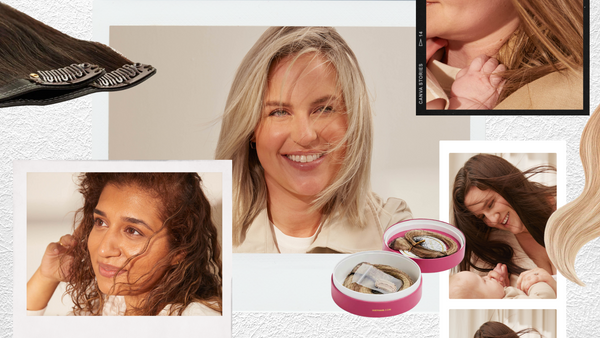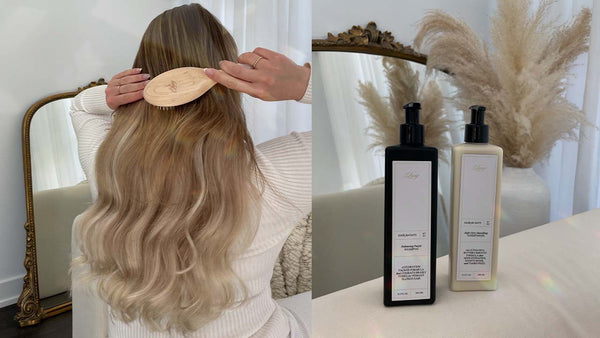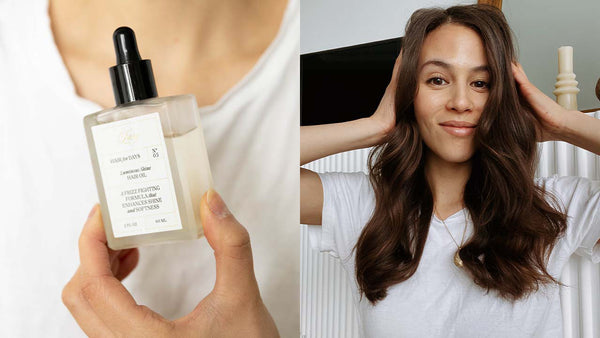Thinking about going green with your hair care routine? Now more than ever, it’s important to make eco-conscious choices for our environment and the earth’s oceans. While the beauty industry is known for contributing to pollution, change is afoot with more brands and consumers making sustainable and eco-friendly moves. From minimizing the amount of water you use, to investing in eco-conscious products to recycling your empties, there are plenty of simple ways to make your beauty regimen kinder to the environment. Here are 10 small but significant changes you can make now for a greener beauty routine.
1. Try switching to a shampoo bar

Raise the bar on your hair care regimen with shampoo bars. Making the switch from liquid shampoo to a shampoo bar is a great way to do your part to protect the environment. Many shampoo bars are biodegradable and don’t come in plastic packaging. Additionally, most are made using all-natural ingredients and are typically free of toxic chemicals that could enter waterways and harm animals.
Bar shampoo is essentially the same as liquid shampoo, except for the fact that it is packed into a bar form. The bars are made using the same process as regular soap bars and are packed with additional nourishing ingredients like essential oils. Another fun fact is that shampoo bars were actually the standard before bottled shampoos became popular in the 1940s. Bar shampoos have numerous benefits, apart from being environmentally friendly. They are compact and easy to travel with, cost-effective, and are formulated for all hair types. They are also designed to remove product build-up and dirt, so using a shampoo bar will leave your locks looking shiny and oh-so clean.
2. Read the labels

When shopping for new hair care products, it’s always a good idea to question what you’re putting on your skin and hair instead of just assuming it is safe. Many hair care products on the market today are filled with nasty chemicals that are harmful to the environment and your health. Be sure to read the labels thoroughly, avoiding any products that contain phthalates, mercury, toluene, lead, formaldehyde, petroleum distillates, parabens (hormone-disrupting preservatives), or BHA. While some labels can be long and intimidating with more than 20 ingredients listed, the most important information about a product lives here on the back of the bottle. Each ingredient will affect your hair in some way, so it’s a good idea to know exactly what you are using and how it will impact your health and the environment as a whole.
3. Upcycle your empty containers

Want to be creative while saving the planet? Instead of throwing away your empty shampoo or conditioner bottles, give upcycling a try. Upcycling, also known as creative reuse, is the process of turning waste or unwanted items into something new and useful. There are dozens of fun ways you can reuse your empty bottles without tossing them out and adding to the thousands of plastic bottles that get sent to landfills each year. For example, you could transform your empties into a makeup brush holder or a cute plant pot. You could also create a shower caddy out of used shampoo bottles or make a soap holder to take with you to the gym. The possibilities are truly endless.
4. Rinse out your conditioner faster

Fun fact: if 50 people rinse out their conditioner 10 seconds faster, 9,000 litres of water would be saved. Changing the way you wash your hair can seriously help reduce your overall carbon footprint. Since it is important to ensure that hair is properly moisturized, you can try using environmentally-friendly products like fast-rinse conditioners. These conditioners will make every shower a little more eco-conscious by saving water while giving you smooth hair. Each wash shaves off about 10 seconds of conditioning time and leaves your mane feeling perfectly soft and pretty.
5. Experiment with heatless hairstyles

Do the planet a favor and take a break from your blow dryer. Skipping time with heat styling tools like straighteners and curlers is not only good for the environment but also healthy for your mane. Using heat on your hair too often can cause drying and damage. The best part about limiting heat styling and being more energy efficient means that you will get to challenge yourself to style your locks without heat. Luckily there are plenty of great heatless hairstyle alternatives you can try out. Maybe take some volumizing hair extensions for a spin or experiment with bangs using clip-in bangs. Hair extensions are a great (commitment-free) way to get instant length and volume, no blow dryer required.
6. Seek out eco-friendly products

One of the best ways you can reduce your hair routine’s carbon footprint is by investing in organic products made with earth-conscious ingredients. Look for packaging made from recycled plastic or the USDA Organic certification, which indicates that products are held to a high standard of sustainability. There are a lot of great vegan-friendly beauty and hair-care lines around that are also worth incorporating into your routine. One amazing brand to try is Love Beauty and Planet. Not only are the products great for your hair, but they are made with ethically-sourced essential oils like sandalwood from Australia.
7. Use less water

There are plenty of ways to keep your water use in check. One easy approach is to join the washcloth revolution. When you clean your face, use a wet sponge or washcloth to take the product off your face instead of leaving the water running. Not only does this save water, but you can actually get better skin as it exfoliates dead skin cells away. Another way to reduce your water consumption is by saying no to bath time. Yes, we know a warm bath can be super relaxing but they use a lot of water. Just one bath can use over 150 liters of water! Start by cutting back on the number of baths you take each month. You can also swap bath time for a shower or only fill the tub up halfway.
8. Do a product cleanse

Go green by getting rid of any old, expired or harmful hair products you may have laying around your bathroom. Start by tossing out any items that contain synthetic chemicals or harmful hormones. Even trace amounts of chemicals can accumulate in our bodies over time. It’s also a good idea to remove products that are past their prime. Expired hair products can be ineffective, full of bacteria, and irritating. While many products do not come with clear expiration dates, a good rule of thumb to follow is that anything in a jar (pomades, gels, styling creams) will spoil more quickly, while oils will expire after about two to three years.
9. Take cold showers

Did you know that heating hot water is typically the most energy intensive activity? A ten-minute shower using an electric immersion heater is the same as leaving a normal television on for 20 hours. While it no doubt helps to turn off lights and other energy-using appliances, the real way to save the environment in your home is by slashing the use of hot water. The longer the shower and the hotter the water, the more energy intensive and costly it will be to both your wallet and the planet).
10. Dry your locks with organic cotton towels

Skipping regular cotton towels in favor of organic cotton ones has tons of environmental benefits. The textile industry is currently responsible for 10% of the planet’s carbon footprint and the dyeing of textiles causes 17% of all industrial water pollution. So when it comes to replacing your towels and linens, flex your purchasing power and go organic. Organic materials are made with crops that have not been treated with pesticides and insecticides, which reduces soil erosion, lowers water and energy use during production, and also reduces run-off of harmful chemicals into waterways. Stocking your bathroom with organic towels is a great way to be gentle on the environment. These towels are free of pollutants, harsh chemicals, and dyes, making them perfect for sensitive skin.
Feeling motivated to save the planet? Your hair routine is a simple and easy place to start. From choosing organic products and recycled packaging, to reducing your water and energy use, there are so many eco-friendly changes you can make to your hair care routine that will have a positive impact on the earth and your hair. Maybe try challenging yourself by experimenting with heatless hairstyle and hair extensions, or get creative by upcycling your empty bottles and transforming them into something beautiful. Ultimately, any of us can support sustainability by going green with our hair care routine.
Written by: Mikayla Uber








